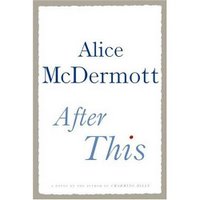
Alice McDermott's After This and William Boyd's Restless were two novels that intrigued me at the Book Expo America earlier this year. I thought BEA was rather listless; the publishers seemed more interested in new technologies and new promotional programs than in their own books. When the show was focused on books, it was almost exclusively nonfiction titles that got the attention, with the exception of the hoopla surrounding Charles Frazier's follow up to Cold Mountain, Thirteen Moons.
I came away from the show, held in Washington D.C., with my fill of glad-handing politicians and glib political commentators, but barely a handful of valued advance reader's copies. Usually, I mail a box of books back home. This time I had no trouble carrying the scant collection of titles in my luggage.
McDermott and Boyd are two writers that don't get nearly the attention that they deserve. McDermott won the National Book Award for Charming Billy in 1998, but is rarely mentioned in the ranks of the top American novelists. Boyd, whose Any Human Heart is one of the two or three best works of fiction since 2000 as far as I'm concerned, won the Whitbread award for his first novel, but doesn't seem to even get noticed when it's time to name the Man Booker Prize in England.
Restless, due out on Oct. 10, was not what I expected from the highly literate Boyd, but it was a page-turning thriller that kept me guessing and had me perusing the internet to discover the history behind the story. The plot involves British spies operating in the United States at the beginning of World War II. Boyd goes into some detail about how the operation worked, including the manipulation of both the print and radio media. It was all in an effort to persuade Americans to enter the war as allies of the British. Of course, Pearl Harbor was a much more effective way to make that happen.
Boyd's novel focuses on Eva Delectorskaya who joins the British Secret Service after her brother dies. One narrative follows her actions during the war, while the other joins her in 1976 living as Sally Gilmartin in the English countryside. Sally believes someone is trying to kill her and enlists her incredulous daughter's help. The daughter, a single mother, is learning about her mother's true identity for the first time.
Boyd does a fantastic job of weaving these plots together into a coherent story filled with "a-ha" moments without ever resorting to spy novel conventions and cliches. True, it doesn't compare to his weightier novels, but it's worth checking out.

After This, due out on Sept. 5, was a pure joy to read simply for McDermott's beautiful use of the language and her descriptive scenes. I don't think it really matters what McDermott writes about or what characters populate her stories. The woman could write a how-to manual and the words would swirl around in my head, creating an ethereal experience.
Luckily for most readers, McDermott spins her prose magic in a multi-layered story, set over several decades. We first meet Mary, a lonely office worker during World War II, coming out of a Catholic Church in Manhattan. Within a few pages she meets John Keane, the man she will marry, in a diner.
McDermott doesn't give us the courtship. She sets up the scene of John and Mary's meeting, and then we are thrust forward, first to their love-making and then to a scene with three of their children. Each episode is beautifully rendered and almost a short story by itself. We are asked to slowly connect the dots between the vignettes. This is how McDermott proceeds with the story all the way into the 1970s.
In many ways it works because it allows McDermott to do what she does best, which is to draw intimate moments and give them emotional weight beyond their obvious meaning. We know that we are seeing everything for a reason since so much is left out of the novel. Occasionally, a gap will be filled in by a memory or a snippet of a conversation, but often we are left to figure out the past.
One problem, however, is that the story shifts between John, Mary, their four children, their family friend and even complete strangers. It makes it difficult to really settle into the story in a satisfying way. Not only are we jumping in time from scene to scene, we are moving into someone else's head. I felt the Keane family would have been better served with interconnected short stories that could have stayed with the individual characters a bit longer.
It's really a small quibble, because the story of this Catholic family dealing with the social upheaval that occurred between 1950 and 1975 in suburban America is endlessly enthralling in the hands of one of our greatest stylists. But it's hard not to wish for perfection when it seems like McDermott just might be able to pull it off.






2 comments:
Arsen,
The site looks great. Can't wait to see more. A couple of ideas -
1) Sports books - who knows more about this than you?
2) Music (books and music)
3) Sex books - what could be more fun to review?
Cheers,
Peter
Wait - you were just in DC and didn't call me or Laury? Grrrrr....
Ok. You get a pass this time. Next time, we inflict punishment.
:) XO
Post a Comment